SafAlert Notifier

SECTION VI. Using ComTekk SafAlert
Ver. 3
CONTENTS
- Running SafAlert
- SafAlert Console Screen
- Preferences (Settings)
- Windows Volume Control
- Windows Recording Control
- Alert Log File
1. Running ComTekk SafAlert
![]()
If you haven't yet done so, install the software and enter your registration key if you have already purchased a license. SafAlert will fully function without a license for a 15-day trial period for up to 10 tones & 10 responders.
Once SafAlert has been successfully installed, you may simply double-click the SafAlert desktop icon or Click the Windows Start menu, then Programs, choose the ComTekk folder, then SafAlert.
Continue on to Section 2 below for detailed description of the buttons and screens.
2. The SafAlert Console
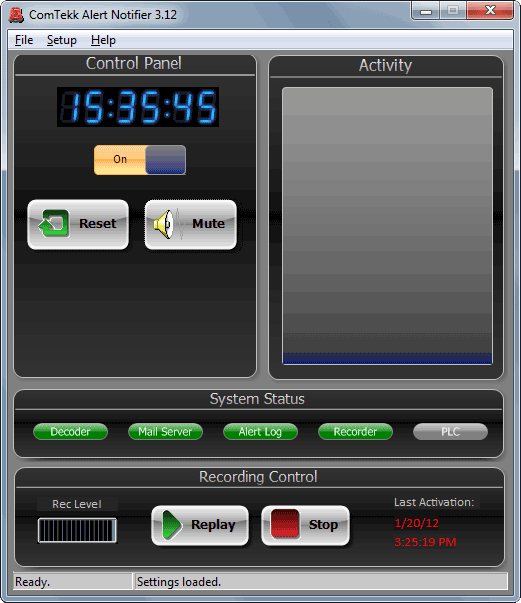
The main console screen consists of four panels, Control Panel, Activity, System Status, and Recording Control plus the Main Menu and Status Bar at the bottom of the window. All controls are operated using a single click of the left mouse button unless otherwise indicated.
2.1 Control Panel - This panel contains the most-used controls and indicators.
Master ON/OFF switch - turns the decoder on or off. Use the OFF position as standby mode to ignore received alerts. When master switch is OFF, the automated features including email, logging and recording will not function either. This is a good time to update settings, tone-out list or alert list. When ON, the Decoder status indicator will be green, and RED when OFF (standby).
To actuate, click the word "On" or "Off". Button will slide to left or right, indicating new status.
Mute button - This will simply mute the receiver audio so it is not heard through the computer speakers. If you prefer to hear all radio traffic on the receiver, leave unMuted.
Reset button - After an alert activation, this will silence the local audio/visual alarm as configured in Alert Options.
Repeat Timer Indicator - Appears as a red LED in the lower right corner of the Control Panel after an alert, if enabled in Alert Options. This feature helps prevent duplicate alerts from being emailed twice.
Alert Indicator - Flashes on alert activation if enabled in Alert Options. The Unit ID name will appear above the beacon light graphic.
2.2 System Status panel - Four lighted indicators give a real-time status of each major sub-system:
Legend OFF / Disabled ON / Enabled / Ok Warning Error Condition Busy, working Decoder - Master ON/OFF status indicator. Blue indicates decoding is in progress.
Mail Server - Green when ready, Red indicates error while sending messages. Yellow, unable to connect to email server on last test. See Diagnostic settings for more.
Alert Log - Active on Green, turns Red if an error writing to log file was encountered.
Recorder - Turns Blue when recording WAVE audio, red if an error was detected.
PLC - Power Line Communications (X10) status, green when enabled and adaptor is online. NOTE: This is an optional feature
2.3 Recording Control panel - Includes Instant Replay controls and date/time of last recorded alert.
Play button - disabled until an alert recording has been completed. Click to start audio playback of last recorded alert dispatch.
Stop button - stops audio playback, resets to beginning of file.
Last Activation - Indicates date and time of last alert received.
2.4 Status Bar - provides another layer of real-time status information.
Left pane - Indicates status of various sub-systems
Right pane - gives additional details, such as error messages, file names, unit IDs, etc.
2.5 Main Menu
File->
View Log - Opens the log file for viewing [more...]
Data -> Backup / Restore - Backup or restore Alert List files (email and tones). From the open/save dialog, choose backup or restore location for Tones and Emails files (XML format).
A/V Test - Click to see/hear a simulated alert based on your chosen local alert settings
Exit - Shut down and exit SafAlert. A YES/NO confirmation dialog will appear if enabled in General Settings.
Setup->
Preferences - Opens the SafAlert Settings window. Requires password if protect option is enabled.
Alert List - Opens the Tone-out and Email Lists for viewing/editing. Requires password if protect option is enabled.
Volume - Opens the Windows Volume Control (Shortcut: Ctrl+L)
PLC - Click to open the X10 PLC Control window (Shortcut: Ctrl+X) NOTE: will be grayed out if option not purchased.
Help->
Help Contents - opens the SafAlert user manual [this file] in your default HTML viewer or Internet browser (Shortcut: F1 key)
About - Displays information about this software
Register - used to enter your license activation key
2.6 Activity panel - Serves as a live visual message queue, displaying the Unit ID name for each alert received. Names are cleared from the queue as messages are sent. If email is disabled, entries will remain visible until another alert is received. The time of activation is displayed in the upper right, and text message (from Tone-out List) in the lower section.

2.7 System Tray Icon - When SafAlert is minimized, only the tray icon
will remain visible in the lower right-hand corner of the Windows Desktop. Click the icon to show the console window. Right-click the icon to show the popup menu with options About, Restore, Setup, Exit.
3. Preferences [Settings] Window
To access the settings screen :
From the Main Menu, click Setup -> Preferences
Click here for help on Settings.
4. Windows Volume Control
This section is provided as a reference - it should not be necessary to adjust these settings for proper operation of SafAlert.
Windows Volume Control (Output): [Windows 95, 98, NT, XP, 2000, ME] - scroll down for Windows 7 / Vista.
This screen controls the sound card OUTPUTS and will generally have no effect on the decoder, since it uses the sound card INPUTS, which are controlled by the Recording Control (see next section below).
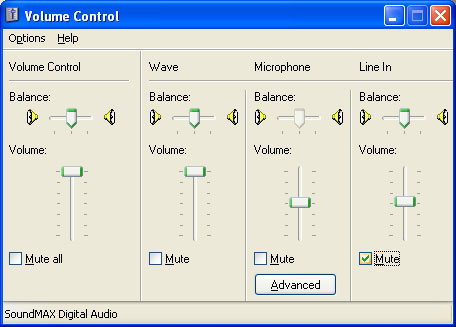
Windows 7/Vista playback [output] settings, accessible from Windows Control Panel
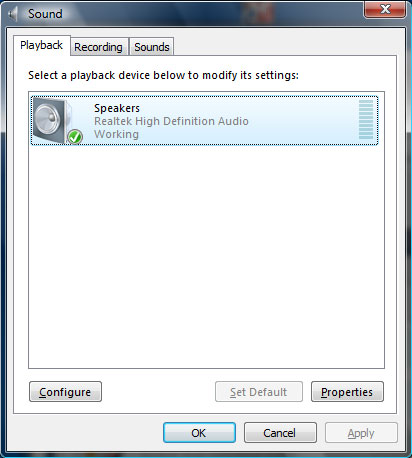
Click "Properties" then select the "Levels" tab for playback mixer controls. Again, these controls will have NO effect on the decoder's operation:
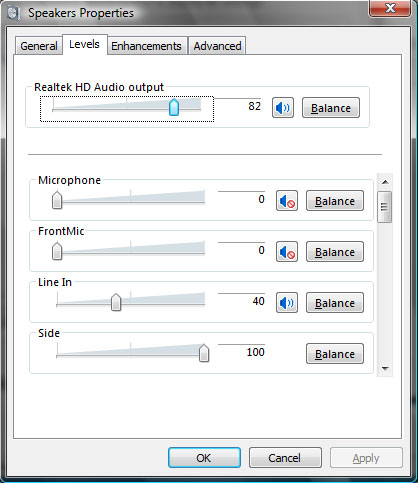
5. Windows Recording Control
This section is provided as a reference - it should not be necessary to adjust these settings for proper operation of SafAlert.
[Windows 95, 98, NT, XP, 2000, ME] - affects sound device INPUTS, such as LINE , AUX, Wave, or Microphone. Vista/7 users, scroll down.
To access Recording controls, click the Mixer button in the Settings window, or with a double-click on the speaker icon in your system tray. Select "Options" from the menu, then "Properties." Click the "Recording" radio button. Input should be selected here. See SafAlert Audio settings.
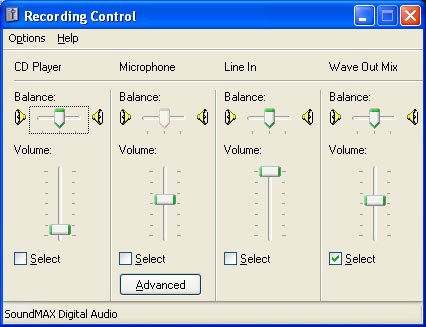
For Windows 7 / Vista Users, click the Mixer button in the Settings window. Line In is selected in the example below.
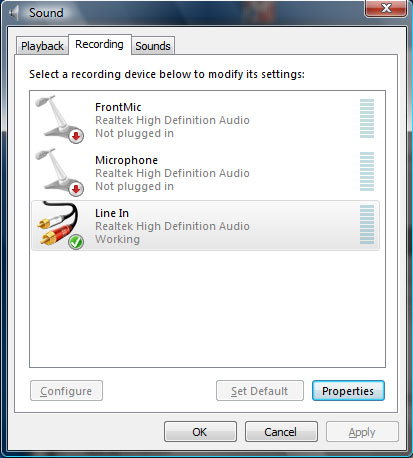
Click Properties then select the Levels tab for Line In level control. This sets the audio level sent to the Decoder.
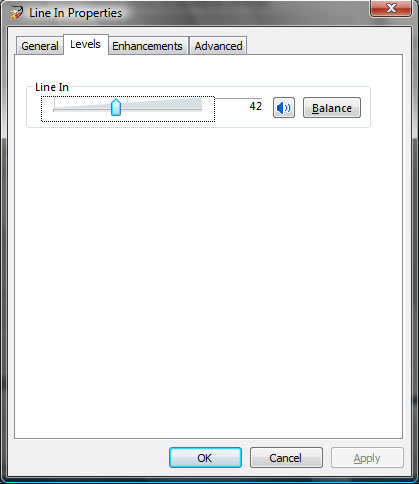
Additionally, the program may be given exclusive control of the selected device by checking the box below. This prevents the user from accidentally changing settings for this device. While not required, this option may be helpful in some cases.
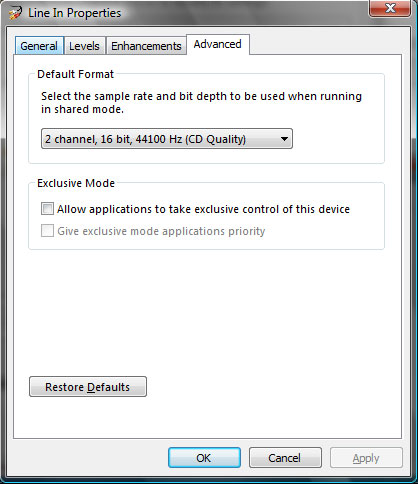
6. Alert Log File
To enable the text log feature, click the "Log File" checkbox in Settings->Alert Options. The Open File dialog will pop up - select a new file name and folder, OR select an existing file to append a previous log. You will be prompted whether to append the file. The Alert Log status indicator will be GREEN when logging is enabled.
To stop/disable logging, just click to un-check the "Log File" checkbox. For convenience, the last folder used is saved upon closing the program.
Each alert saved with Unit ID, date, and time. The last field contains the WAV file name/path if audio recording has been enabled.
To view the log file while SafAlert is running, select File->View Log from the Main Menu. Double-click the log entry to replay audio file. The Play button on main screen will be activated. Clicking the Stop button will stop playback.
If any new alerts were received while viewer is open, click the Refresh button to reload the log file.
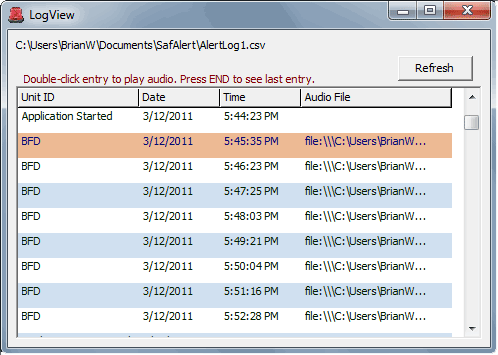
More about Log Files:
The log file is a text file, saved in .CSV (Comma Separated Value) format, which can easily be viewed and edited with Microsoft Excel, OpenOffice, or any text editor, such as Notepad or WordPad.
Tip: If you don't have Microsoft Excel, CSView is available as a free download.
IMPORTANT NOTE: If the log file is open for viewing by another program such as Excel, SafAlert cannot update the file. Therefore, if tones are decoded and an attempt is made by the program to update the log file, an error will result, and logging will be automatically disabled.
TIP: It is possible to hear the recordings simply by clicking on the wave file name in MS Excel after performing the following steps.
1. Click on the cell containing the file name.
2. Press the F2 key, then press Enter.
3. Repeat for each file name cell.
4. To keep your changes, save the log file in .XLS format using the "Save As" command from the File menu.
For file locations see Appendix C.
Disclaimer:
Actual performance may vary between different computers and sound cards. The author makes no warranties or guarantees of performance or suitability for any particular purpose, and assumes no liability whatsoever for the use or misuse of any software products. This product is not intended for use as a primary means of notification. The author cannot guarantee timely message delivery and has no control over the Internet, third-party mail servers, or carrier networks.

